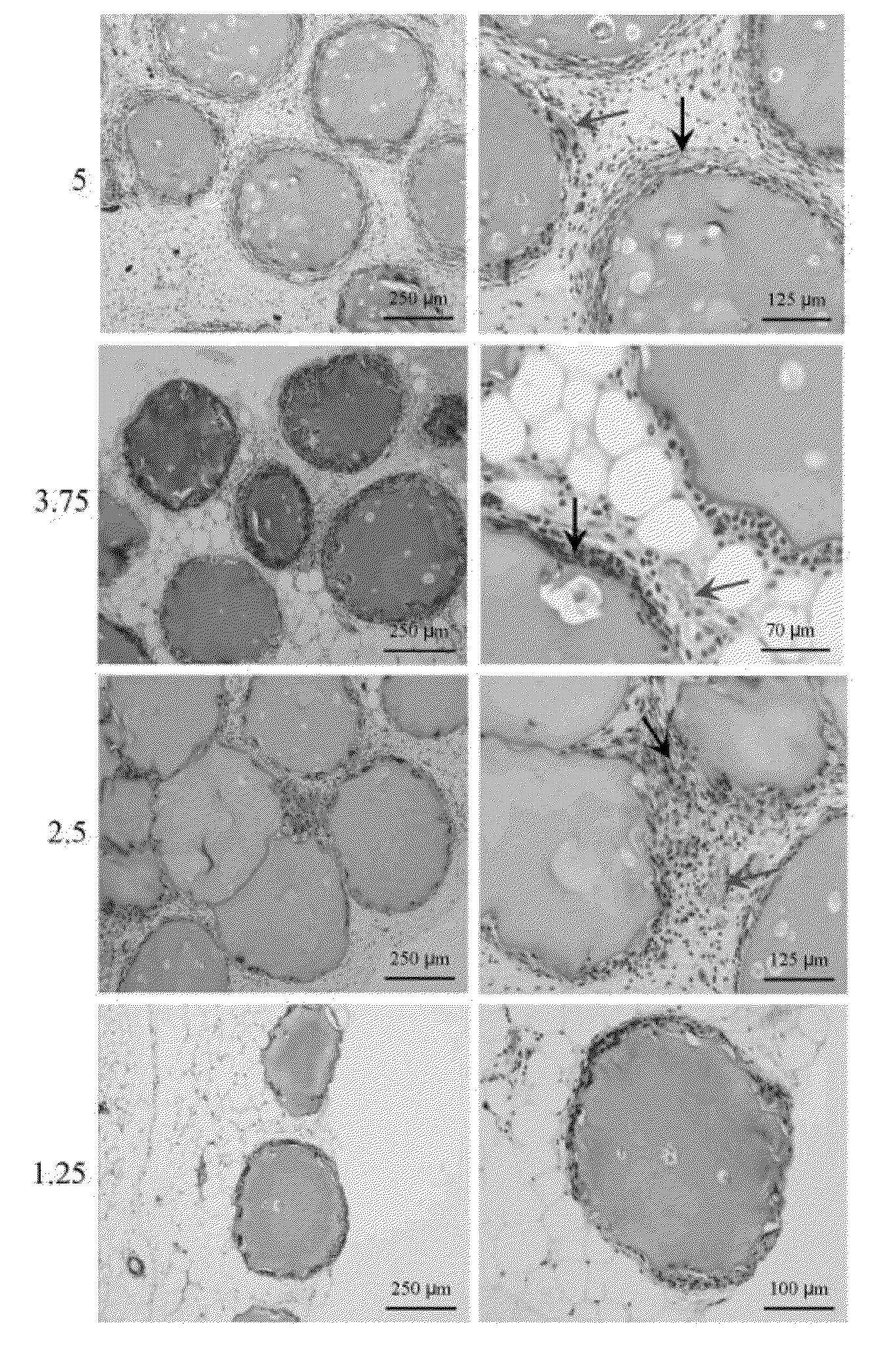Rgd-modified alginate microparticles as a drug release system
a technology of rgd-modified alginate and microparticles, which is applied in the field of encapsulated cell systems, can solve the problems of capsules lacking high stability, progressive weakening of the structure of the microcapsule, and insufficient microenvironment for cell viability
- Summary
- Abstract
- Description
- Claims
- Application Information
AI Technical Summary
Benefits of technology
Problems solved by technology
Method used
Image
Examples
example 1
[0067]The molecular weight of the alginate molecules rich in guluronic acid residues (Protanal LF240 D, FMC Technologies) was adjusted by means of irradiation with a cobalt 60 source. The irradiation doses ranged from 2 to 5 Mrads. The final molecular weight of the alginate molecules was analyzed by means of gel filtration chromatography (Viscotek).
[0068]After irradiation, the alginate molecules were modified with synthetic oligopeptides containing the (glycine)4-arginine-glycine-aspartic acid-tyrosine sequences (GGGGRGDY, Commonwealth Biotechnology Inc.) using to that end aqueous carbodiimide reactions [1]. Briefly, alginate solutions were prepared in a 2-[N-morpholino]ethanesulfonic acid hydrate buffer (MES, Sigma) which were subsequently mixed with N-hydroxysulfosuccinimide (sulfo-NHS, Pierce Chemical), and 1-ethyl-3-[3-(dimethylamino)propyl]carbodiimide (EDC, Sigma) and the oligopeptides. After reacting for 24 hours, the modified alginate molecules were purified using filters (F...
example 2
Adhesive and Biomimetic Effects of RGD Alginates
[0070]To evaluate the adhesive and biomimetic effects of RGD alginates, erythropoietin (EPO)-secreting mouse C2C12 skeletal myoblasts modified by genetic engineering were selected as candidate cells and mixed with the binary polymer solution. It was observed that both the RGD concentration and the alginate composition could control the phenotype of the myoblasts. These cells can be easily handled and once encapsulated and implanted in the host, they irreversibly come out of the cell cycle and fuse in multinucleated myofibrils. The latter is essential for controlling the therapeutic dose and for preventing possible biosafety risks. EPO was selected as model drug due to its resulting therapeutic effects and because it is easy to monitor its in vivo expression and bioactivity by following its hematocrit level. Furthermore, due to its weak pharmacokinetics, it is expected that cell encapsulation technology can prevent the continuous and re...
example 3
Viability and Functionality of the Myoblasts in the RGD Alginate Matrixes
[0073]To characterize the viability and functionality of the myoblasts in the matrixes, the cell metabolic activity and the release of EPO were studied in vitro during a 3-week period. These studies did not show major differences between the two types of microcapsules in cell viability or in the release of EPO in the short term. After 21 days in culture, the EPO secretion of RGD alginate microcapsules loaded with 100 cells measured was 71±9 IU of EPO / 24 h, whereas the production in non-modified alginate matrixes was 72±5 IU EPO / 24 h. These results suggest that the cells adapt satisfactorily to the new microenvironments. However, for the purpose of evaluating the possible impact of matrixes bioactivated with RGD on the survival and long-term functionality of encapsulated cells, 0.2 mL of both types of microcapsules (RGD alginate, 5×106 cells / mL alginate) were implanted in subcutaneous tissue of immunocompetent B...
PUM
| Property | Measurement | Unit |
|---|---|---|
| diameter | aaaaa | aaaaa |
| diameter | aaaaa | aaaaa |
| cell adhesion | aaaaa | aaaaa |
Abstract
Description
Claims
Application Information
 Login to View More
Login to View More - R&D
- Intellectual Property
- Life Sciences
- Materials
- Tech Scout
- Unparalleled Data Quality
- Higher Quality Content
- 60% Fewer Hallucinations
Browse by: Latest US Patents, China's latest patents, Technical Efficacy Thesaurus, Application Domain, Technology Topic, Popular Technical Reports.
© 2025 PatSnap. All rights reserved.Legal|Privacy policy|Modern Slavery Act Transparency Statement|Sitemap|About US| Contact US: help@patsnap.com



